2002 North Main Street
Santa Ana, California 92706
TEL: 714.567.3600
Coils and Swamp Oils: Baskets of the Emberá-Wounaan
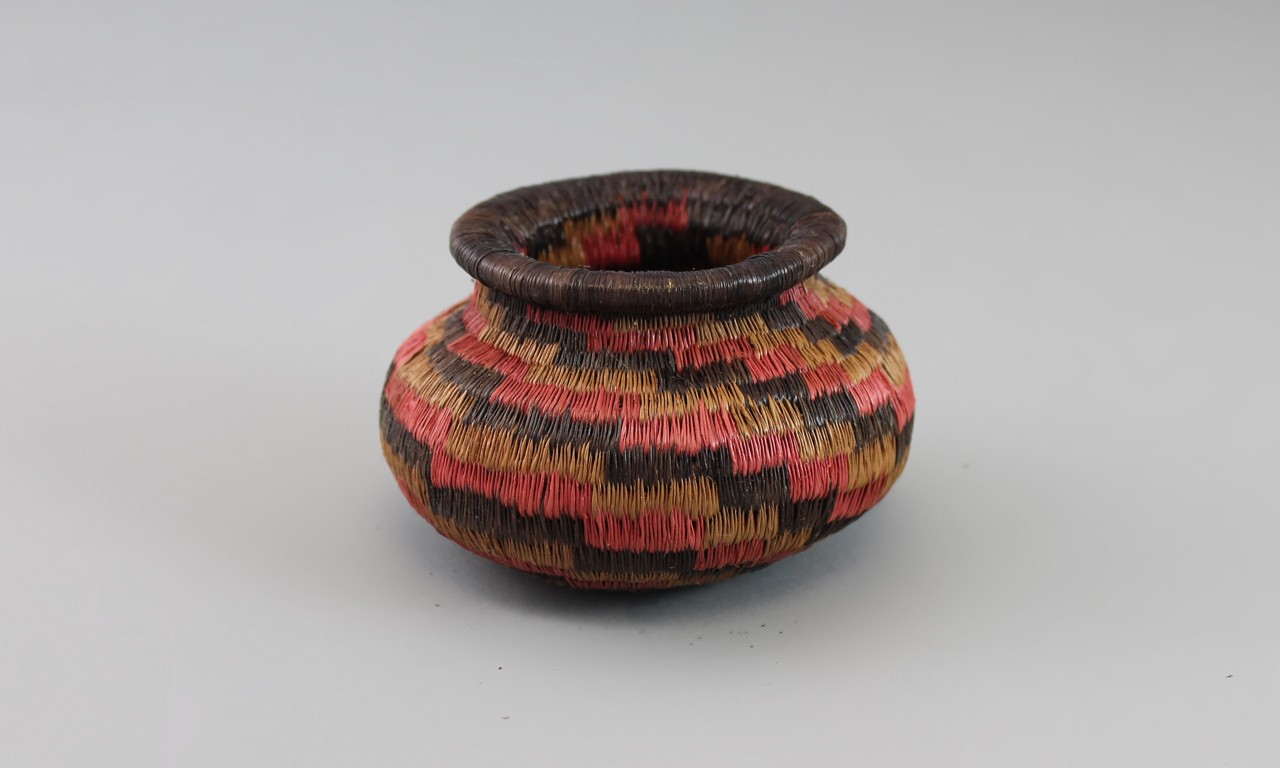 |
| Miniature Basket (Hösig Di), mid to late 20th Century Emberá or Wounaan culture; Darién Province, Panama Palm fibers (astrocaryum standleyanum and carludovica palmata) and natural pigments; 2 x 3 3/8 x 3 3/8 in. 2020.9.53 Gift of Anne and Long Shung Shih |
Oh, What an Untangled Baskets They Weave
Over the globe various basketry techniques are employed to create vessels, trays, baby carriers and even armor. What most pieces have in common is a sense of utilitarian function, but this is not uniformly the case. The Emberá and Wounaan cultures of southern Panama have transitioned over the past 50 years into creating purely decorative pieces as small as half an inch in height. This blog post looks at a new acquisition of 170 miniature baskets from the region, exploring the history of their creators as well as the craft involved in weaving these baskets.
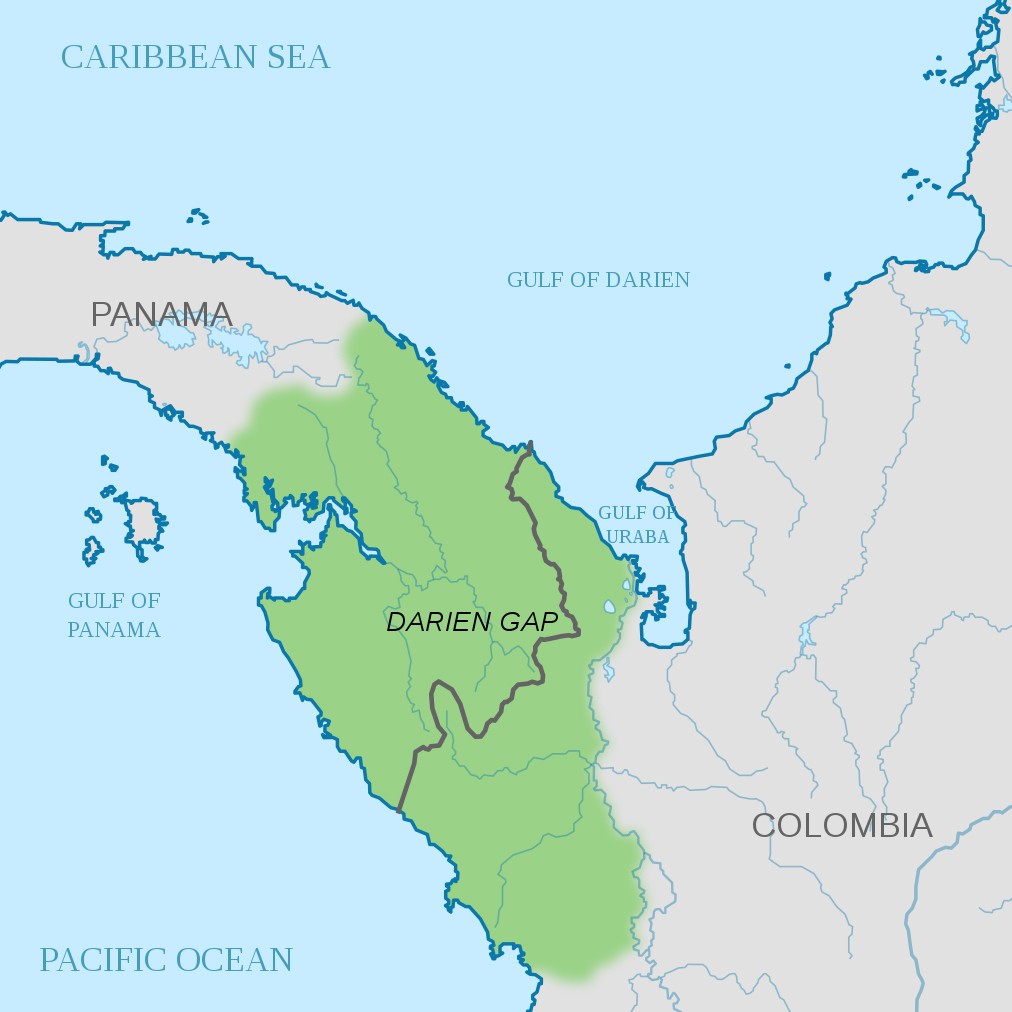 |
| Map of the Darien Gap, roughly showing the region discussed in this post By Milenioscuro and licensed under CC BY-SA 4.0 |
Brief History of Darién
The Emberá-Wounaan are a cultural supergroup now living in the Darién Province of Panama. Back in the 1600s, the Spanish attempted to colonize the area—then occupied by the Kuna culture—after gold was discovered in the local mountains. The resulting conflict between the Spanish and the Kuna led the Spanish to hire Emberá warriors from what is now northern Columbia. To escape the resulting battles, the Kuna migrated east to the San Blas Islands and the Emberá moved into the recently abandoned territory, mostly settling along the shores of rivers. Over the course of the 20th century, ongoing violence in Colombia’s Chocó department forced the native Wounaan to move away from their home to major cities like Bogotá and to the same areas of southern Panama as the Emberá.
|
|
| Miniature Baskets (Hösig Di), mid to late 20th Century Emberá or Wounaan culture; Darién Province, Panama Palm fibers (astrocaryum standleyanum and carludovica palmata) and natural pigments 2020.9.16,.18,.23,.28,.31,.41,.42,.52,.53,.67,.82,.89,.97,.102,.104,.114 Gift of Anne and Long Shung Shih |
Adopt and Overcome
While both groups had traditions of basket weaving, the coiling method practiced in contemporary baskets appears to date back to approximately the 1970s. Rather than originating with either the Wounaan or the Emberá, the technique likely came in part from a missionary group and was synthesized into the preexisting tradition to create a hybrid style that is practiced today. The new method produced baskets that were so tightly woven that they could hold water without any sort of sealant, and in part due to the added utility were readily adopted by the Wounaan under the name hösig di. Given the proximity of the Emberá, they too began creating the style of basket seen in this post. Around 1985 the baskets began to be sold as a tourist art, further affecting the types of baskets that were made. This collection was formerly owned by Virginia Davies, who around 2005 went to Panama to help set up computers for weavers so that they could sell their artworks online. Now these baskets allow Emberá and Wounaan women to support themselves financially.
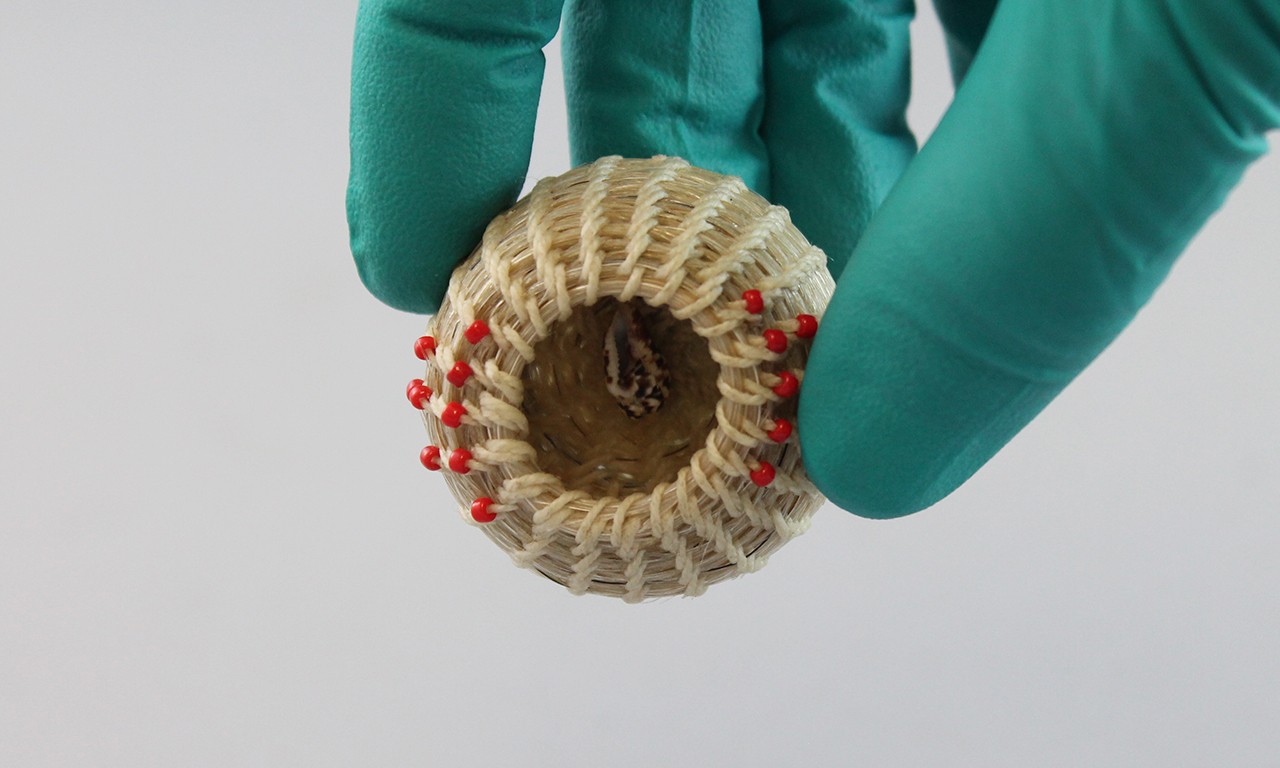 |
| Miniature Basket (Hösig Di), mid to late 20th Century Emberá or Wounaan culture; Darién Province, Panama Palm fibers (astrocaryum standleyanum and carludovica palmata) and natural pigments; 5/8 x 1 1/2 x 1 1/2 in. 2020.9.170 Gift of Anne and Long Shung Shih |
The Dye is Cast
Baskets made by the Wounaan are crafted from several different species of palms, and then dyed using pigments that are made locally. Frames for the baskets are woven from Carludovica palmata, a sturdier fiber that allows the baskets to maintain rigid forms. Harvested or purchased spear leaf fibers of a second palm, astrocaryum standleyanum are dyed using several different methods to create different colors: black and dark blue are made from the fruit of Genipa americana, which is also used for traditional bodypainting and as a natural insect repellent; the deep olive green is made using swamp oil; and other colors are made from the leaves, seeds, roots, fruits and sawdust of a variety of plants harvested in plantations, home gardens and neighboring forests. Once processed, the thinner fibers are tightly wrapped around those of the frame with dyed sections used to create designs.
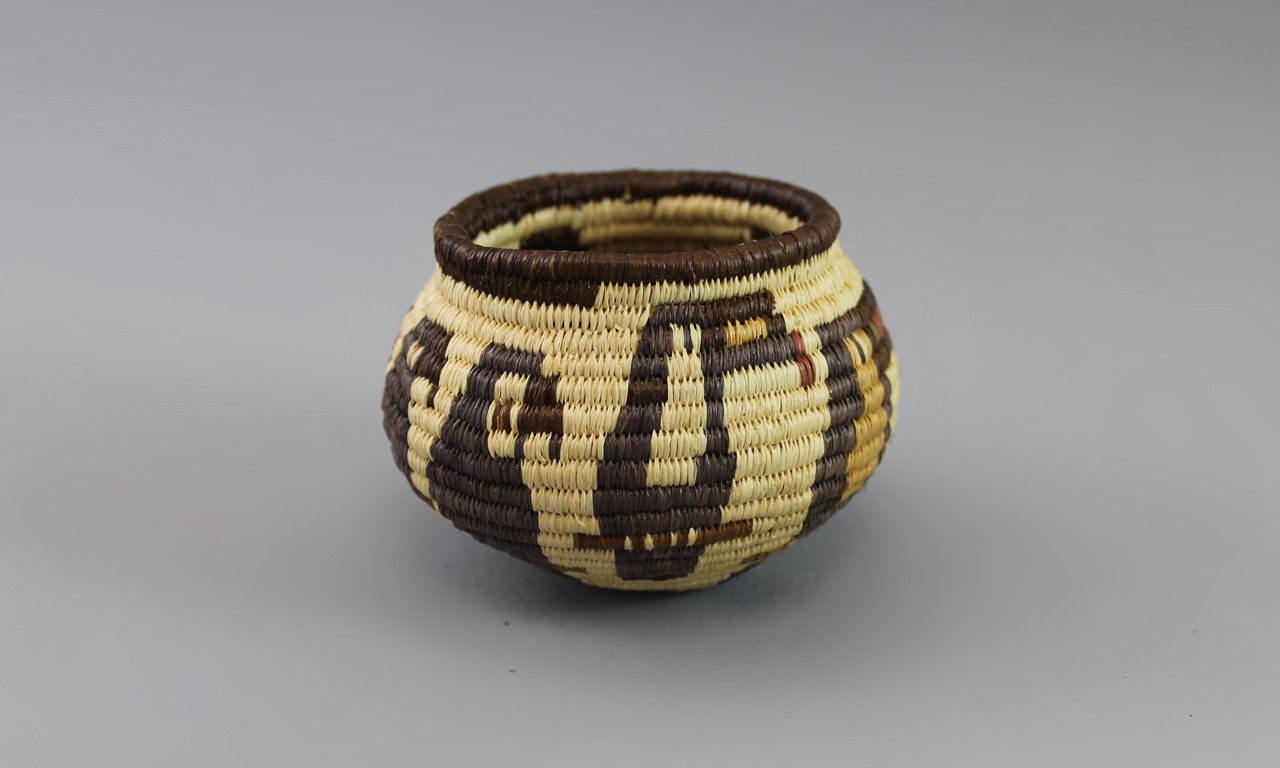 |
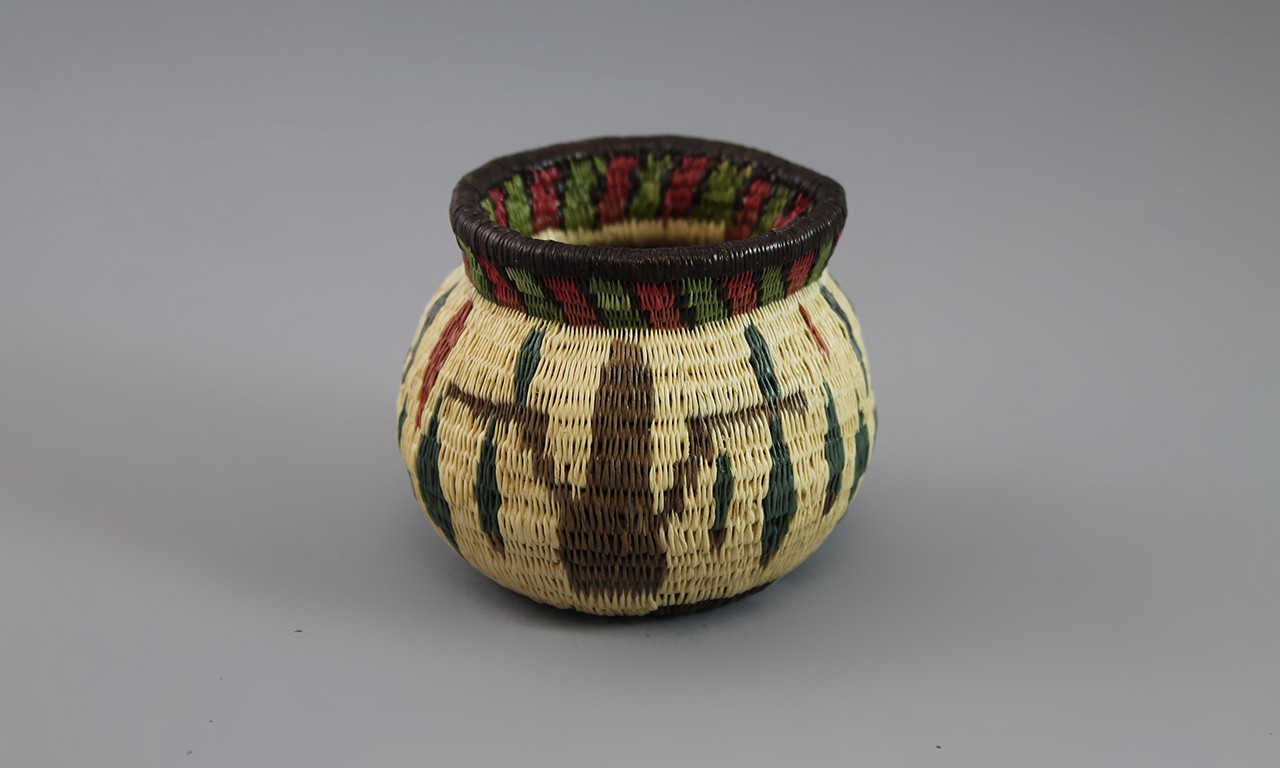 |
| Miniature Baskets (Hösig Di), mid to late 20th Century Emberá or Wounaan culture; Darién Province, Panama Palm fibers (astrocaryum standleyanum and carludovica palmata) and natural pigments 2020.9.56,.72 Gift of Anne and Long Shung Shih |
|
Good Things in Small Packages
The size of the Bowers Museums’ new collection offers a wonderful survey of the different designs used by Emberá-Wounaan weavers, with the individual baskets’ size also being of note. Before baskets were made for export, the designs of the Wounaan were almost exclusively geometric, sometimes incorporating anthropomorphic motifs much in the same way as the cultures’ traditional body paintings still do. Though there was already a universe of possibilities just using variations of characteristic geometric designs like the meander, checkerboard patterns, spirals, stars and more, weavers began to introduce zoomorphic and other figurative designs when they saw just how popular they were with buyers. The result is baskets like those with the bird and tree motifs featured in this post. Now that utility is no longer a consideration for weavers, baskets are often made to be under five inches in height. Though small of stature, the baskets of the Emberá-Wounaan remain important pieces of Central American folk art for their incredible marriage of color, traditionally inspired designs, and synthetic coiling technique.
Text and images may be under copyright. Please contact Collection Department for permission to use. References are available on request. Information subject to change upon further research.

Comments